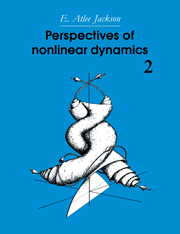Book contents
- Frontmatter
- Contents
- Preface
- Acknowledgements
- 6 Models based on second order difference equations
- 7 Models based on third order differential systems
- 8 ‘Moderate-order’ systems
- 9 Solitaires: solitons and nonsolitons
- 10 Coupled maps (CM) and cellular automata (CA)
- Epilogue: ‘Understanding’ complex systems: Order; organization; Endnote–models, causality, irreversibility
- Appendixes
- Bibliography
- References added at 1991 reprinting
- Cumulative index (Volumes 1 and 2)
Epilogue: ‘Understanding’ complex systems: Order; organization; Endnote–models, causality, irreversibility
Published online by Cambridge University Press: 19 February 2010
- Frontmatter
- Contents
- Preface
- Acknowledgements
- 6 Models based on second order difference equations
- 7 Models based on third order differential systems
- 8 ‘Moderate-order’ systems
- 9 Solitaires: solitons and nonsolitons
- 10 Coupled maps (CM) and cellular automata (CA)
- Epilogue: ‘Understanding’ complex systems: Order; organization; Endnote–models, causality, irreversibility
- Appendixes
- Bibliography
- References added at 1991 reprinting
- Cumulative index (Volumes 1 and 2)
Summary
Life is complicated, so it is not surprising that most dynamic systems are also ‘complicated’. One of the challenges of the future is to obtain some level of ‘under-standing’ of these dynamic complications. This understanding hopefully will involve, for limited groups of systems, the identification of categories of behavior of observable properties, which can be qualitatively classified and/or quantitatively measured. This process has hardly begun and what follows should certainly be approached with a spirit of adventure; value judgements should be developed only after a considerable period of personal reflection. Above all, the reader should be very cautious about accepting pronouncements made in the existing literature, even when the authors are world-renowned for other research. The world is full of inflated egos which result in pontifications that are not supported by solid knowledge. We all might benefit, before we look at details, by reflecting with Newton:
I do not know what I may appear to the world, but to myself I seem to have been only like a boy playing on the seashore and diverting myself in now and then finding a smoother pebble or a prettier shell than ordinary whilst the great ocean of truth lay all undiscovered before me.
The following analysis suggests that any ‘understanding’ first requires the explicit recognition that there are various ‘modes of complexity,’ which depend not only on the physical systems, but also on our methods of representing, observing and interacting with these systems. In this spirit, we need first to distinguish clearly (Fig. El) …
- Type
- Chapter
- Information
- Perspectives of Nonlinear Dynamics , pp. 505 - 528Publisher: Cambridge University PressPrint publication year: 1990

